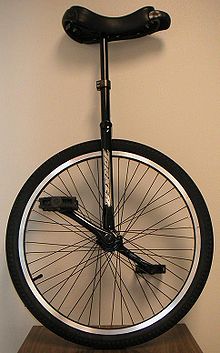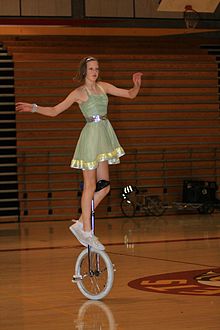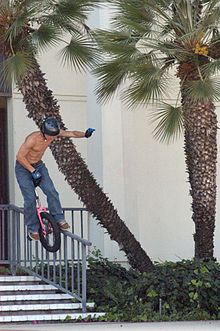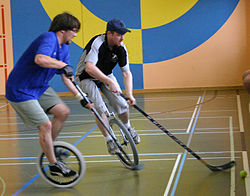- Unicycle
-
A unicycle is a human-powered, single-track vehicle with one wheel. Unicycles resemble bicycles, but are less complex.
Contents
History
One theory of the advent of the unicycle stems from the popularity of the penny-farthing (or "Ordinary") during the late 19th century. Since the pedal and cranks were connected directly to the front axle, the rear wheel would go up in the air and the rider would be moved slightly forward. Many penny-farthing owners discovered they could dispense with the frame and just ride the front wheel and handlebars. Evidence for this theory of development can reportedly be found in pictures from the late 19th century showing unicycles with large wheels.[1]
Over the years, unicycle enthusiasts have inspired manufacturers to create new designs, such as seatless ("ultimate wheel") and tall ("giraffe") unicycles. During the late 1980s some extreme sportsmen took an interest in the unicycle and started off-road unicycling (MUni(Mountain Unicycling)).
Construction
Unicycles have a few key parts:
- the wheel (which includes the tire, tube, rim, spokes, hub and axle)
- the cranks
- pedals
- fork-style frame
- seatpost
- saddle (the seat of the unicycle)
The wheel usually looks like a bicycle wheel with a special hub designed so the axle is a fixed part of the hub. This means the rotation of the cranks directly controls the rotation of the wheel (called direct drive). The frame sits on top of the axle bearings, while the cranks attach to the ends of the axle. The seatpost links the frame to the saddle.
Types of unicycle include:
- freestyle unicycles
- trials unicycles
- MUnis
- giraffes
- long distance unicycles
Each type has special components unique to that type of unicycle.
Training aids
Having training aids may make it easier to become comfortable with riding a unicycle. One method for training is using a spotter to make riding easier. One other easy way to learn is to find a narrow hallway that can be used to help alleviate left and right balancing while allowing a beginner to focus on forward and backward balance. If a hallway cannot be found, a fence or clothes line is suitable. Equally, riding back and forth between two chairs, faced back to back, whilst holding on to the chair backs allows the user to gauge how to appropriately position themself before setting off. Using props such as sticks or ski poles is generally discouraged as they hinder balance, create dependence, and a fall onto props could cause serious injury.[2]
Types of unicycles
Freestyle unicycles
Generally used for flatland skills and freestyle routines. Usually have a relatively high seatpost, a narrow saddle, and a squared fork (used for one-footed tricks). These unicycles are used similarly to flatland bicycles. Wheel size is usually 20 inches (510 mm), but smaller riders may use 16-inch (410 mm) or 12-inch (300 mm) unicycles. Some people prefer 24-inch (610 mm) wheels.
Trials unicycles
Designed for unicycle trials, trials unicycles are stronger than standard unicycles in order to withstand the stresses caused by jumping, dropping, and supporting the weight of the unicycle and rider on components such as the pedals and cranks. Many trials unicycles also have wide, 19- or 20-inch (510 mm) knobby tires to absorb some of the impact on drops.
Offroad unicycles ("MUnis")
"MUni" or "muni" is an abbreviation for mountain unicycling. MUnis have many of the same components as trials unicycles, but have a few key differences. Usually, the tire diameters on mountain unicycles are either 24 or 26 inches (660 mm), allowing the rider to more easily roll over obstacles such as roots and rocks. The seat is also thicker and more comfortable on MUnis to compensate for the rough terrain. Brakes are sometimes used for steep descents.
Touring unicycles
Used for long distances, these unicycles are specially made to cover distances. They have a large wheel diameter, between 26 and 36 in., so more distance is covered in less pedal rotation. A 36" unicycle made by the Coker Tire company started the big wheel trend.[3] Some variations on the traditional touring unicycle include the Schlumpf "GUni" (geared unicycle), which uses a two-speed internal fixed-geared hub. Larger direct-drive wheels tend to have shorter cranks to allow for easier cadence and more speed. Geared wheels, with an effective diameter larger than the wheel itself, tend to use longer cranks to increase torque as they are not required to achieve such high candences as direct-drive wheels, but demand greater force per pedal stroke.
Other variations
 Giraffe unicycle
Giraffe unicycle
- Giraffe: a chain-driven unicycle. use of a chain can make the unicycle much taller than standard unicycles (note that multi-wheel unicycles can be described as giraffes).[4] Standard unicycles don't have a chain, which limits the seat height based on how long the rider's legs are, because there the crank is attached directly to the wheel axle. Giraffe unicycles can range in heights from 3 feet to over 10 feet high.
- Geared unicycle ("GUni"): a unicycle whose wheel rotates faster than the pedal cadence. They are used for distance riding and racing.[5]
- Multi-wheeled unicycle: a unicycle with more than one wheel, stacked on top of each other so that only one wheel touches the ground (nicknamed stacks). The wheels are linked together by chains or direct contact with each other.
- Kangaroo unicycle: a unicycle that has both the cranks facing in the same direction. They are so named due to the hopping motion of the rider's legs, supposedly resembling the jumping of a kangaroo.
- Eccentric unicycle: a unicycle that has the hub off-center in the wheel. Putting an eccentric wheel on a kangaroo unicycle can make riding easier, and the rider's motion appear more kangaroo-like.
- Ultimate wheel: a unicycle with no frame or seat, just a wheel and pedals.
- Impossible wheel (BC wheel): a wheel with pegs or metal plates connected to the axle for the rider to stand on. These wheels are for coasting and jumping. A purist form of unicycle, without cranks.
- Monocycle (or monowheel): a large wheel inside which the rider sits (as in a hamster wheel), either motorized or pedal-powered. The greater gyroscopic properties and lower center of mass make it easier to balance than a normal unicycle but less maneuverable.
- Self-balancing unicycle: a computer-controlled, motor-driven, self-balancing unicycle.
- Freewheeling unicycle: a unicycle in which the hub has a freewheel mechanism, allowing the rider to coast or move forward without pedaling, as a common bicycle does. These unicycles almost always have brakes because they cannot stop the way traditional unicycles do. The brake lever is generally mounted in the bottom of the saddle. These unicycles also cannot go backwards.
Other variations include:
- tandem
- recumbent
- hydraulic giraffe
- unibike[clarification needed]
- suicycle[clarification needed]
- motorized unicycle
Theory
As with bicycles, unicycles lack stability when stationary, and under most circumstances can only remain upright when moving. Experimentation and mathematical analysis have shown that a unicycle stays upright when it is steered to keep its wheel beneath its center of mass (inverse pendulum control theory). This steering is supplied by a rider. Long-standing hypotheses and claims that gyroscopic effect is the main stabilizing force have been discredited. Unicycles are also a nonholonomic system because its outcome is path-dependent. The problem of controlling a self-balancing unicycle forms an interesting problem in control theory. (See Segway.)
In order to ride the unicycle a proficient rider subconsciously notices they are falling and corrects it (bringing the wheel under their centre of gravity) before the unicycle moves far from its unstable equilibrium. While remaining upright may be the primary goal of beginning riders, they must (in order to voluntarily turn, accelerate or decelerate) allow themselves to 'fall' in the appropriate direction, before correcting it.
The horizontal distance between the centre of gravity and the contact point (between the wheel and the floor) determines the acceleration in a particular direction. The speed and direction of the wheel's rotation (pedalling) then determines the relative position of the contact point (and thus the increase/decrease in acceleration).
If a unicyclist is (far) off balance they can't move their centre of gravity to the other side of the wheel (the base of which is the fulcrum) without pushing off a wall (or similar)—so in order not to fall over, they must turn the wheel (with their lower body) and move it (by pedalling) underneath their centre of gravity.
Voluntary movement in a particular direction involves allowing a rider's centre of gravity to 'fall' in the direction they desire to move, generally this begins by subtle arm motions or leaning. Once more proficient, a rider may twist their hips (and counter rotate their body) in order to line up the wheel with the direction, they are going to fall toward, before they begin 'falling' in that direction, and thus they can immediately begin riding in that direction despite any sudden change in velocity.
Once a rider is in motion they shift their centre of gravity forward of the wheel's contact point to accelerate, shift it behind to decelerate, and keep their centre of gravity over the contact point to maintain a constant velocity. But significantly (and counter intuitively) the most significant way to affect the acceleration acting on the rider's centre of gravity is by adjusting their pedalling speed and direction, and thus the contact point, not by leaning their body.
Speed
The pedals of a typical unicycle (e.g. not a giraffe or guni) connect directly to the wheel. This means that there are no gears to shift and provides a very direct feel of the wheel contact with the ground. It also means that wheel size is a major factor in unicycle speeds:[6]
Wheel size Avg[citation needed] High[citation needed] 20" 5 mph (8.0 km/h) 9 mph (14 km/h) 24" 7 mph (11 km/h) 12 mph (19 km/h) 29" 10 mph (16 km/h) 17 mph (27 km/h) 36" 11 mph (18 km/h) 28 mph (45 km/h) Riding styles
Traditionally, unicycling has been connected by the public with parades or with the circus. Recent developments in the strength and durability of bicycle (and consequently unicycle) parts have given rise to many riding styles such as trials unicycling and mountain unicycling. Unicycling has therefore developed from primarily an entertainment activity to a competitive sport and recreational pursuit.
- Freestyle
- Perhaps the oldest form of extreme unicycling, traditional freestyle riding is based on performance. Freestyle tricks and moves are derived from different ways of riding the unicycle, and linking these moves together into one long flowing line that is aesthetically pleasing.
- Trials unicycling
- Trials unicycling is specifically aimed at negotiating obstacles. Analogous to trials bike riding.
- Street unicycling
- Street unicycling as a style of unicycling involves riders using a combination of objects found in urbanized settings (such as ledges, handrails, and stairs) to perform a wide variety of tricks. Many tricks are similar to those performed in other extreme sports, such as BMX and skateboarding.
- Off-road or mountain unicycling (MUni)
- Unicycling on rough terrain has been the swiftest growing form of unicycling in recent years.[citation needed] Any place a mountain bike can go, a mountain unicycle can go as well — and sometimes more easily, due to the unicycle's greater maneuverability.
- Touring or commuting
- This style concentrates on distance riding. With a 29-inch (740 mm) or 36-inch (910 mm) wheel cruising speeds of 10 to 15 mph (24 km/h) can easily be reached. However, the smallest wheel diameter to fit within the "touring" category is 26 inches (660 mm).[citation needed]
- Flatland
- As of 2009[update] flatland is a relatively new form of unicycling. By definition it follows the same rules as freestyle: to do various trick and move on flat ground. Flatland, however, does not have the performance element of freestyle.
Unicycle team sports
In addition to individual efforts, team sports played on unicycles have also grown in popularity.[citation needed]
Unicycle basketball
Main article: Unicycle basketballUnicycle basketball uses a regulation basketball on a regular basketball court with the same rules, e.g., one must dribble the ball while riding. There are a number of rules that are particular to unicycle basketball as well, e.g., a player must be mounted on the unicycle when in-bounding the ball. Unicycle basketball is usually played using 24 inches (610 mm) or smaller unicycles, and using plastic pedals, both to preserve the court and the players' shins. In North America, regular unicycle basketball games are organized in Berkeley,[7] Detroit, Phoenix, Minneapolis, and Toronto. Switzerland, France, Germany and Puerto Rico all field teams. The Puerto Rico All Stars has been one of the dominant teams and has won several world championships.
Unicycle hockey
Main article: Unicycle hockeyUnicycle hockey follows rules basically similar to ice hockey or inline hockey, using a tennis ball and ice-hockey sticks. Play is mostly non-contact. The sport has active leagues in Germany, Switzerland and the UK and international tournaments held at least bi-annually. Tournaments in the UK are held by various teams across the country usually in sports halls, but occasionally outside. Each tournament lasts a day and around 8 teams normally compete in a round-robin league with the winner being whoever has the most points. If two teams have the same number of points the winner can be decided by goal difference or a penalty shoot-out.
Unicycle handball
Unicycle handball uses a handball-sized ball. The teams aim to throw it into a vertical hoop placed about 6 feet (1.8 m) above the ground It has been played in the Polish village of Chrzelice since late 1970s[8][9]
Equipment and safety
- Wrist guards
- The most common impact points when falling from a unicycle are the hands and wrists. Of all the safety gear, wrist guards receive the most wear and tear.
- Knee and elbow pads
- The second most common impact point are the knees followed by the elbows. Knee pads are required for events like racing and MUni.
- Helmet
- A helmet becomes especially important when partaking in specialty riding such as MUni and, in some jurisdictions, is required for road riding as well as racing; MUni and other events. The helmet is helpful against hitting your head on the ground as for trees and branches.
- Shin guards
- Shin guards become a necessary piece of equipment when using metal or pinned pedals. These types of pedals grip the shoes better, but can cause injury to the legs.
- Cycling shorts
- Padded cycling shorts are designed with a seamless, padded crotch, and long enough legs to extend down past the saddle, making them much more comfortable than "normal" shorts.
- Gloves
- Gloves are required at some unicycling events such as racing. Gloves may be fingerless (but are not recommended). They are also very useful for protecting the hands in Muni and Trials riding.
Notable unicyclists
Known as unicyclists
- John Foss, holder of many world unicycling records
- Kris Holm and Dan Heaton, pioneers in mountain unicycling
- Terry "UniGeezer" Peterson, MUnicyclist and record holder for steepest unicycle climb at Fargo street hill climb event, 3/6/11
- Rudy Horn, a German juggler
- Ernest Montego, a German juggler
Known in other fields
- Demetri Martin, American comedian and actor[citation needed]
- Adam Carolla, American comedian and actor[citation needed]
- Rupert Grint, actor in the Harry Potter films as Ronald Weasley[citation needed]
- Mika Häkkinen, Formula One racing driver[10]
- Leslie Mann, American actress who performed on The Ellen DeGeneres Show[citation needed]
- Michael Nesmith, former guitarist of The Monkees[citation needed]
- Donald Rumsfeld, former United States Secretary of Defense[10]
- Claude Shannon, founder of information theory
- Peter Tosh: Jamaican reggae musician from The Wailers (1963-1974 band)
- Chris Moyles, Radio 1 DJ and broadcaster[citation needed]
- Gary Barlow, singer in Take That[citation needed]
- Howard Donald, singer in Take That[citation needed]
- Jason Orange, singer in Take That[citation needed]
- Mark Owen, singer in Take That[citation needed]
- Rebecca Caine, Canadian Opera singer and musical actress[citation needed]
- Michael Crawford, Actor and singer[citation needed]
- Eddie Izzard, Comedian and actor[citation needed]
- Sam Pepper, contestant in Big Brother 2010 (UK)[citation needed]
- Chris Martin, lead singer of Coldplay[citation needed]
Take That learned how to unicycle for the circus-based video for their song "Said It All"[citation needed]
UNICON
The biennial UNICON (International Unicycling Convention), sanctioned by the International Unicycling Federation, comprises all major unicycling events and is the premiere event on the international unicycling calendar. Events include: artistic (group, pairs, individual, standard skill, open-X), track racing (100 metres, 400 metres, 800 metres, 30 metres walk the wheel, 50 metres one-foot), 10 kilometres, marathon (42.195 km), muni (cross-country, uphill, downhill, North Shore downhill), trials, basketball and hockey.[11]
The 2004 UNICON was held in Tokyo, Japan.
The 2006 UNICON was held in Langenthal, Switzerland.
The 2008 UNICON was held in Frederiksberg, Denmark.
The 2010 UNICON was held in Wellington, New Zealand.Future UNICON:
The 2012 UNICON will be held in Brixen, Italy.
Races
The world's first multi-stage unicycle race, Ride the Lobster, took place in Nova Scotia in June 2008. Some 35 teams from 14 countries competed over a total distance of 800 km.[12] Each team consisted of a maximum of 3 riders and 1 support person.
Unicross, or unicycle cyclocross is an emerging race format in which unicycles race over a cyclocross course.
Unicycle manufacturing companies
Notable unicycle manufacturing companies include:
- Coker
- Nimbus Unicycles (Made and Sold at Unicycle.com)
- Koxx-One
- Kris Holm Unicycles
- Miyata
- Surly
- Torker
See also
- Bicycle and motorcycle dynamics
- Self-balancing unicycle
- Monowheel
- Unicycle robot
References
- ^ Foss, John. "Unicycle.com, Educational Articles: Novelty Unicycles". http://www.unicycle.com/educationarticledetail.asp?CatID=8&ID=38. Retrieved 2009-01-28.[dead link]
- ^ Wiley, Jack (1973). The unicycle book. Pennsylvania: Stackpole Books. ISBN 0811704165.
- ^ "“To Coker” is a verb with one wheel and tire on it!". http://blog.coker.com/index.php/2008/01/11/to-coker-is-a-verb-with-one-wheel-and-tire-on-it/#more-151. Retrieved 2008-05-13.
- ^ Freeland, Ben. "Unicycling". http://www.outlawnet.com/outlaw/sisters_middleschool/fun/free/unic/unicycle.html. Retrieved 2009-05-22.[dead link]
- ^ Holm, Kris; Schlumpf. "Geared Unicycle Hub". http://www.unicycle.uk.com/shop/shopdisplayproduct.asp?catalogid=1062. Retrieved 2009-05-22.[dead link]
- ^ Gilby's Website: UAM Logbook - Miles 0 to 100
- ^ Comcast SportsNet Feature about Berkeley Unicycle Basketball
- ^ How it started in Chrzelice (Polish)
- ^ Pictures of handball played by former and current members of Chrzelice unicycle team
- ^ a b Unicyclist.org - image
- ^ International Unicycling Federation
- ^ Ride the Lobster
External links
- Unicyclist.org - Huge archive of clips on unicycle skills
- Unicycling.org - Massive resource of unicycling information
- Unicyclopedia - a wiki containing lots of information about unicycling and unicycles
- Unicycle Hockey Video
- Unicycle Pictures - Unicycle picture gallery with free upload
- Unicycling Photos and Videos - A large collection of unicycling photos and videos
- Berkeley Revolution Unicycle Basketball Team
- [1] - The Singapore Unicyclists Homepage
Human-powered transport Land Pedal powerBicycle · Bicycle trailer · Cycle rickshaw · Freight bicycle · Mountain bike · Party Bike · Quadracycle · Recumbent bicycle · Road bike · Tandem bicycle · Trailer bike · Tricycle · Trikke · Unicycle · Velocar · Velocipede · VelomobileHand-powerRow-actionRowing cyclesFoot powerPushed/pulledBaby transport · Baggage cart · Gurney · Handcart · Hand truck · Pulled rickshaw · Shopping cart · Stairclimber · WheelbarrowCarriedWater Snow and ice Alpine touring skis · Crampons · Cross-country skis · Ice skates · Kicksled · Snowshoes · Telemark skis · Snowboard · SledAir Categories:- Circus skills
- Cycle types
- Unicycling
- Physical activity and dexterity toys
Wikimedia Foundation. 2010.





